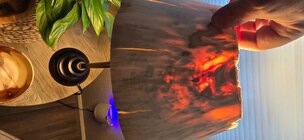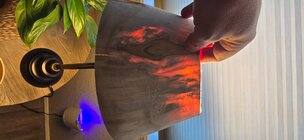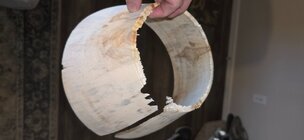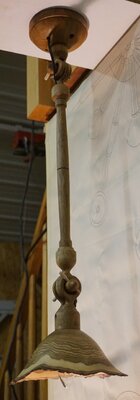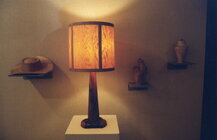I've been thinking about making a lampshade for a while. I am still a rookie on the lathe, been turning about 9 months. But being in Colorado I have plenty of access to aspen and that is one of the best woods for lampshades so I really want to learn how to do it. I felt ready for a challenge, and jumped in.
Screwed a faceplate to log. Mount log to Jet 1640. Add tailstock support. Attach it with bowl gauge, rough out, start fine tuning with roughing spindle gauge. In my pea-brained mind (and having never done this before), I was going to make the lampshade with the right side of the log, and part it off the rest of the log attached to the headstock when it was done.
I think that was mistake #1. In the future I will chainsaw-rough out a "cone" that will be the rough shape of the lampshade, and...... I don't know. Waste block? Open to suggestions.
Shaped the outside, removed as much wood as I could. Started on the inside. Mistake #2! Looking back I am embarrassed, but I just planned on the end of the log being the bottom, wide end of the shade. Hey, cracks and all! SMH. Should have sliced off cookies with the chainsaw until I hit clean wood. The cracks kept me from really getting the bottom 1/3rd as thin as the rest.
Mistake #3. I do not own a pair of calipers. I will own a pair of calipers by suppertime today via Amazon. Pretty much REQUIRED for this project. There is no way to comprehend a 16th of an inch 8 inches down a shade by pointing 2 fingers at eachother from inside and outside. LOL.
So, sand the outside to 240. Screw the inside. At this point I knew this was a prototype. Call the wife out catch the shade as I parted it off. We both fail. Equally. And spectacularly. Project over, hahaha.
So next time: Cut off ends of logs and get to clean wood. Prep a blemish free "cone". Own and use calipers. Still contemplating how to part off the top of the shade.
Suggestions welcome, and don't be like me.
Screwed a faceplate to log. Mount log to Jet 1640. Add tailstock support. Attach it with bowl gauge, rough out, start fine tuning with roughing spindle gauge. In my pea-brained mind (and having never done this before), I was going to make the lampshade with the right side of the log, and part it off the rest of the log attached to the headstock when it was done.
I think that was mistake #1. In the future I will chainsaw-rough out a "cone" that will be the rough shape of the lampshade, and...... I don't know. Waste block? Open to suggestions.
Shaped the outside, removed as much wood as I could. Started on the inside. Mistake #2! Looking back I am embarrassed, but I just planned on the end of the log being the bottom, wide end of the shade. Hey, cracks and all! SMH. Should have sliced off cookies with the chainsaw until I hit clean wood. The cracks kept me from really getting the bottom 1/3rd as thin as the rest.
Mistake #3. I do not own a pair of calipers. I will own a pair of calipers by suppertime today via Amazon. Pretty much REQUIRED for this project. There is no way to comprehend a 16th of an inch 8 inches down a shade by pointing 2 fingers at eachother from inside and outside. LOL.
So, sand the outside to 240. Screw the inside. At this point I knew this was a prototype. Call the wife out catch the shade as I parted it off. We both fail. Equally. And spectacularly. Project over, hahaha.
So next time: Cut off ends of logs and get to clean wood. Prep a blemish free "cone". Own and use calipers. Still contemplating how to part off the top of the shade.
Suggestions welcome, and don't be like me.

